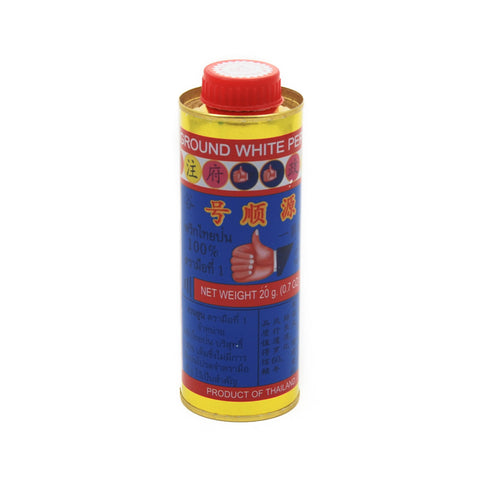What is a White Pepper? Everything You Need to Know
by Jannika Resido

White pepper comes from the same plant as black pepper. But it undergoes a different processing method.
Unlike black pepper, which is harvested when the berries are still unripe and then dried, white pepper is harvested as fully ripened berries.
They are then soaked in water to ferment, stripping away the outer layer to expose the lighter-colored inner seed.
This process means white pepper has a milder flavour and smoother texture compared to black pepper. Plus it has a more floral, stronger aroma than black pepper.
Browse all white pepper at Sous Chef here, or take a look at our collection of black pepper.
What is a White Pepper?
The Inner 'Pepper'
White pepper is produced from the fully ripe berries of the Piper nigrum plant, the same plant used to produce black pepper. The key difference lies in the processing.
After harvesting, the outer layer of the berries is removed by soaking them in water for about a week.
This process, known as retting, allows the outer skin to decompose and separate from the core, leaving only the inner seed. The remaining seeds are then dried, creating 'white' peppercorns.
Historically, white pepper has origins in India and Southeast Asia, where it has been used for centuries in traditional dishes.
White Pepper vs Black Pepper
White pepper and black pepper both come from the same pepper plant, Piper nigrum, yet their processing methods create distinct differences.
Black pepper is produced by drying unripe berries, resulting in its characteristic dark colour and robust, pungent flavour.
On the other hand, white pepper involves soaking fully ripe berries to remove the outer skin before drying, yielding a milder, more earthy taste. These processing methods give white and black pepper their distinct tastes.
The choice between white and black pepper often depends on the recipe context. Plus whether you want the seasoning to visible.
Cooks might choose white pepper in light-coloured dishes such as white sauces and mashed potatoes. Additionally, white pepper’s subtle heat complements delicate flavours, whereas black pepper’s strong bite is suited for more robust dishes.
White pepper is commonly used in creamy soups, white sauces, mashed potatoes, and other light-colored dishes, where it blends seamlessly without altering the dish’s appearance.
In Asian cuisine, white pepper is a staple in recipes such as Chinese hot and sour soup, Thai curries, and Vietnamese pho.
It provides a gentle warmth that enhances the flavours of these dishes without overpowering them.
White pepper is also a popular seasoning for Japanese ‘sukiyaki’, a hot-pot style dish made with sliced beef, tofu, mushrooms and shirataki noodles.
How To Use White Pepper
Cooking Techniques
White pepper’s unique flavour profile and appearance make it suitable for various cooking techniques. Ground white pepper, or ground peppercorns, is often used in recipes where a smooth, consistent texture is desired, such as in sauces, soups, and mashed potatoes.
When using whole white peppercorns, they can be added to stocks and broths to infuse a subtle heat and depth of flavour.
Crushing whole peppercorns slightly before adding them to dishes can release more of their aromatic oils, enhancing the overall taste.
Another effective technique is to toast white peppercorns in a dry pan briefly. This process can intensify their flavour and add a smoky note to your dishes.
Popular Recipes With White Pepper
White pepper is an essential ingredient in many popular recipes across different cuisines.
In French cuisine, it is a key component in classic dishes like béchamel sauce and vichyssoise, adding a subtle spice without altering the creamy, white appearance.
Asian cuisines also heavily feature white pepper. For instance, it is used in Chinese hot and sour soup, where its mild heat complements the tangy and savoury flavours.
Thai green curry often incorporates white pepper to enhance the dish's complexity without overpowering the delicate balance of spices.
European dishes such as risottos and seafood chowders benefit from white pepper's earthy notes.
It is also a popular choice for seasoning mashed potatoes and scrambled eggs, providing a gentle heat that elevates these simple dishes.
Pairing White Pepper with Other Spices
White pepper's aromatic and earthy flavour pairs particularly well with ginger and garlic.
The subtle heat of white pepper complements the warmth of ginger and the pungency of garlic, creating a harmonious balance.
White pepper is also often paired with nutmeg and thyme, especially in creamy sauces and soups. The combination of these spices adds depth and complexity to dishes without overwhelming the palate.
The gentle heat of white pepper allows the flavours of cumin and coriander to shine through, contributing to a well-rounded spice profile.
Choosing and Storing White Pepper
When selecting white pepper, quality is paramount to ensuring the best flavour and aroma. High-quality white peppercorns should be uniform in size, clean, and free from any discolouration or mould. They typically have a pale beige hue, indicating proper processing and drying.
For ground white pepper, choose a product with a fine, consistent texture and a fresh, slightly earthy scent.
Proper storage of white pepper is crucial to maintaining its flavour and potency. Whole white peppercorns should be stored in an airtight container, kept in a cool, dry place away from direct sunlight. This prevents moisture and light from degrading the peppercorns, preserving their quality for a longer period.
For ground white pepper, an airtight container is also essential. However, it's best to buy ground pepper in smaller quantities that you can use within a few months, as it tends to lose its flavour more quickly than whole peppercorns.
Avoid storing white pepper near heat sources like stoves or ovens, as heat can accelerate the loss of essential oils and aroma. A pantry or a spice drawer away from heat and light is ideal.

About the author
Jannika Resido is Sous Chef's online content specialist. She is an expert in southeast Asian food and ingredients! Jannika has several years of experience writing blogs and features for online publications. She loves savoury dishes, trying new ingredients (especially the fruity ones!) and discovering recipes from across the world.



